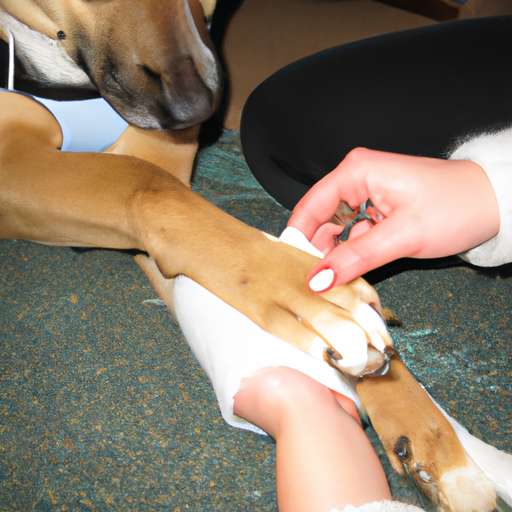Introduction
Hello there, caregiver! I know you’re here because you deeply care for your furry friend and want to make sure they’re as comfortable as possible. In this guide, we’ll go through all the steps on how to properly wrap a dog’s paw. This is a task that may seem daunting, but with patience, love, and a little bit of knowledge, you can do it!
Gathering the Necessary Supplies
First things first, let’s make sure you have all the necessary supplies. For this task, you’ll need:
- Cotton padding
- Non-stick gauze
- Adhesive tape
- Scissors
- Tweezers
- Disposable gloves
| Item | Purpose |
|---|---|
| Cotton padding | For cushioning the paw. |
| Non-stick gauze | To cover the wound or sore area and protect it from dirt and bacteria. |
| Adhesive tape | To secure the gauze and cotton padding in place. |
| Scissors | To cut the tape and gauze. |
| Tweezers | To remove any foreign objects that may be causing the injury. |
| Disposable gloves | To protect both you and your dog from contamination. |
Assessing the Injury
Next, you need to assess your dog’s injury. Carefully examine the paw to identify any foreign objects, cuts, or abrasions. Remember to be gentle, your touch should be soothing, not painful. Use your tweezers to remove any debris that may be lodged in the paw. If the injury is severe, it’s best to seek professional help immediately.
Wrapping the Paw
Now onto the main event – wrapping the paw. Here’s a step-by-step guide:
- Start by gently cleaning the wound with a soft, damp cloth.
- Place a piece of non-stick gauze over the wound.
- Wrap some cotton padding around the paw, covering the gauze.
- Secure the padding with adhesive tape, ensuring it’s snug but not too tight.
- Finally, check the wrap every few hours to ensure it’s still in place and not too tight.
Remember, if your dog shows signs of discomfort or distress at any point, stop immediately and consult with a vet.
Monitoring Your Dog
After successfully wrapping the paw, it’s important to monitor your dog. Keep an eye out for any signs of infection such as redness, swelling, or pus. Additionally, make sure your dog isn’t chewing or licking at the bandage. If any of these occur, contact your vet immediately.
FAQ
Q: How often should I change the bandage?
A: Typically, you should change the bandage every day.
Q: My dog is trying to chew off the bandage, what should I do?
A: Consider using an Elizabethan collar (also known as a cone) to prevent your dog from reaching their paw.
Q: Can I use human bandages for my dog’s paw?
A: No, it’s best to use vet-approved bandages as human bandages can be too adhesive and harm your dog’s fur and skin.
Remember, when in doubt, always seek professional help. Here’s to a speedy recovery for your furry friend!



